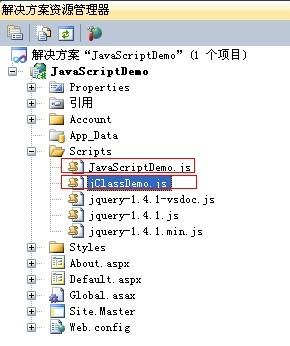javascript继承系列详解
参考文章:http://www.cnblogs.com/sanshi/archive/2009/07/08/1519036.html
新建一个Asp.net项目,在Script下添加两个*.js文件,如下图:

(1)JavaScriptDemo.js文件代码:
//原型(prototype),我们可以简单的把prototype看做是一个模版,新创建的自定义对象都是这个模版(prototype)的一个拷贝 (实际上不是拷贝而是链接,只不过这种链接是不可见,给人们的感觉好像是拷贝)。
// 构造函数
function Person(name, sex) {
this.name = name;
this.sex = sex;
}
// 定义Person的原型,原型中的属性可以被自定义对象引用
Person.prototype={
getName:function(){return this.name;},
getSex:function(){return this.sex;}
}
//当代码var zhang = new Person("ZhangSan", "man")执行时,其实内部做了如下几件事情:
//•创建一个空白对象(new Object())。
//•拷贝Person.prototype中的属性(键值对)到这个空对象中(我们前面提到,内部实现时不是拷贝而是一个隐藏的链接)。
//•将这个对象通过this关键字传递到构造函数中并执行构造函数。
//•将这个对象赋值给变量zhang。
var zhang = new Person("ZhangSan", "man");
function Employee(name, sex, employeeID) {
this.name = name;
this.sex = sex;
this.employeeID = employeeID;
}
Employee.prototype = new Person();
//修正constructor的指向错误
Employee.prototype.constructor = Employee;
Employee.prototype.getEmployeeID = function () { return this.employeeID; };
var chen = new Employee("ChenJunto", "man", "1234");
(2)jClassDemo.js文件代码:
// 当前是否处于创建类的阶段
var initializing = false;
function jClass(baseClass, prop) {
// 只接受一个参数的情况 - jClass(prop)
if (typeof (baseClass) === "object") {
prop = baseClass;
baseClass = null;
}
// 本次调用所创建的类(构造函数)
function F() {
// 如果当前处于实例化类的阶段,则调用init原型函数
if (!initializing) {
// 如果父类存在,则实例对象的baseprototype指向父类的原型
// 这就提供了在实例对象中调用父类方法的途径
if (baseClass) {
this.baseprototype = baseClass.prototype;
}
this.init.apply(this, arguments);
}
}
// 如果此类需要从其它类扩展
if (baseClass) {
initializing = true;
F.prototype = new baseClass();
F.prototype.constructor = F;
initializing = false;
}
// 覆盖父类的同名函数
for (var name in prop) {
if (prop.hasOwnProperty(name)) {
// 如果此类继承自父类baseClass并且父类原型中存在同名函数name
if (baseClass &&
typeof (prop[name]) === "function" &&
typeof (F.prototype[name]) === "function") {
// 重定义函数name -
// 首先在函数上下文设置this.base指向父类原型中的同名函数
// 然后调用函数prop[name],返回函数结果
// 注意:这里的自执行函数创建了一个上下文,这个上下文返回另一个函数,
// 此函数中可以应用此上下文中的变量,这就是闭包(Closure)。
// 这是JavaScript框架开发中常用的技巧。
F.prototype[name] = (function (name, fn) {
return function () {
this.base = baseClass.prototype[name];
return fn.apply(this, arguments);
};
})(name, prop[name]);
} else {
F.prototype[name] = prop[name];
}
}
}
return F;
};
//调用
//创建类与子类以及调用方式都显得非常优雅
var Person = jClass({
init: function (name) {
this.name = name;
},
getName: function () {
return this.name;
}
});
var Employee = jClass(Person, {
init: function (name, employeeID) {
this.base(name);
this.employeeID = employeeID;
},
getEmployeeID: function () {
return this.employeeID;
},
getName: function () {
return "Employee name: " + this.base();
}
});
var zhangJSClassDemo = new Employee("ZhangSan", "1234");
(3)Default.aspx页面中对*.js代码的调用
<%@ Page Title="主页" Language="C#" MasterPageFile="~/Site.master" AutoEventWireup="true"
CodeBehind="Default.aspx.cs" Inherits="JavaScriptDemo._Default" %>
<asp:Content ID="HeaderContent" runat="server" ContentPlaceHolderID="HeadContent">
</asp:Content>
<asp:Content ID="BodyContent" runat="server" ContentPlaceHolderID="MainContent">
<script src="Scripts/JavaScriptDemo.js" type="text/javascript"></script>
<script src="Scripts/jClassDemo.js" type="text/javascript"></script>
<h2>
欢迎使用 ASP.NET!
</h2>
<p>
若要了解关于 ASP.NET 的详细信息,请访问 <a href="http://www.asp.net/cn" title="ASP.NET 网站">www.asp.net/cn</a>。
<input id="Button1" type="button" value="button" onclick="alert(zhang.name)"/>
<input id="Button2" type="button" value="button2" onclick="alert(zhang.getName())"/>
<input id="Button3" type="button" value="button3" onclick="alert(chen.getEmployeeID())"/>
<input id="Button4" type="button" value="button3" onclick="alert(zhangJSClassDemo.getEmployeeID())"/>
</p>
<p>
您还可以找到 <a href="http://go.microsoft.com/fwlink/?LinkID=152368"
title="MSDN ASP.NET 文档">MSDN 上有关 ASP.NET 的文档</a>。
</p>
</asp:Content>


 浙公网安备 33010602011771号
浙公网安备 33010602011771号